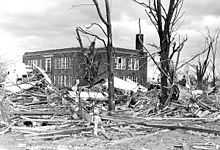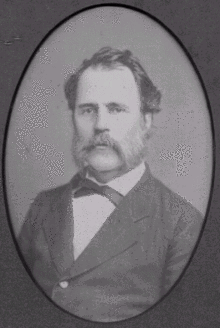Bunker Hill, Illinois
| Bunker Hill | |
| City | |
 Welcome to Bunker Hill | |
| Country | United States |
|---|---|
| State | Illinois |
| County | Macoupin |
| Elevation | 660 ft (201 m) |
| Coordinates | 39°2′29″N 89°57′3″W / 39.04139°N 89.95083°W |
| Area | 1.29 sq mi (3 km2) |
| - land | 1.26 sq mi (3 km2) |
| - water | 0.02 sq mi (0 km2) |
| Population | 1,801 (2000) |
| Density | 1,396 / sq mi (539 / km2) |
| Mayor | Ray Chapman |
| Timezone | CST (UTC-6) |
| - summer (DST) | CDT (UTC-5) |
| ZIP code | 62014 |
| Area code | 618 |
  Location of Bunker Hill within Illinois
| |
| Wikimedia Commons: Bunker Hill, Illinois | |
| Website: www.bunkerhill-il.com | |
Bunker Hill is a city in Macoupin County, Illinois, United States. The population was 1,801 at the 2000 census.
History
Settlement
The original inhabitants of the Bunker Hill area were the Peoria people, Kickapoo people, and Winnebago people. They were forcibly removed from the area by the United States government around 1830.
As Euro-Americans arrived in Macoupin County, the site of the future Bunker Hill was settled in 1830. At that time, the area was known as Wolf Ridge, due to the presence of wolves in the vicinity. The first settler was Elijah Lincoln in 1830, who established a land claim one and a half miles southwest of present Bunker Hill. Shortly after he made his claim, Lincoln and a Mr. Tuttle laid out a town, named Lincoln after the first settler. The earliest post office in the area was established in 1833 a mile south of Lincoln. A school house was built around 1831, and was also used as the meeting hall for the Baptist denomination. The first church in the area was built by the Baptists. The second was the Congregational Church in woodburn.
In 1834, County Surveyor Luke Knowlton entered 80 acres (320,000 m2) of land that now cover the center of Bunker Hill. On 25 December 1835, Moses True of Salisbury, New Hampshire, John Tilden of Boston, Massachusetts, and Robert Smith of Alton, Illinois visited Lincoln and formed a company to plat a town and improve the surrounding countryside. By 1836, the settlement of Lincoln had been abandoned, prompting Moses and company to establish a new town, which became Bunker Hill in 1837.
The tornado of 1948


At 6:45am CST on 19 March 1948, a tornado that originated in Alton, Illinois blew through Bunker Hill, destroying the majority of the town's buildings and killing nineteen people. Although the tornado was only in town for less than a minute, the destruction was devastating. The downtown business district lost many of its buildings. The streets were impassable due to rubble from the storm. The newly renovated Meissner School was one of few buildings virtually undamaged by the tornado. A first aid station was set up in the school, with a temporary morgue in another classroom. By 9:00 am, ambulances from Alton, Carlinville, Litchfield, and Gillespie arrived to transport the injured to local hospitals. By the end of the day, National Guard units, US Army units, the Red Cross, Salvation Army, American Legion, VFW, and Illinois State Police had arrived to restore order and provide assistance to the citizens of Bunker Hill.
The Army and National Guard established patrols to minimize looting, and the State Police set up road blocks to keep sightseers away. The Red Cross, Salvation Army, and Lebanon American Legion opened food stations to feed the volunteers and homeless citizens of the town. Bahn's Grocery Store donated their entire stock for the food stations. A temporary post office was opened in the lobby of the First National Bank. Local farmers brought their tractors and bulldozers to town to clear rubble and reopen the streets.
By evening, the Red Cross had pitched tents in front of Meissner School to house the newly homeless citizens. 126 people were injured and 19 killed by the tornado. Property damage was estimated between four and five million dollars. All five churches in Bunker Hill were destroyed by the tornado, prompting two local ministers, Rev. Burke of the First Congregational Church and Rev. Johnson of the Baptist Church, to conduct the Easter Sunday services on 28 March 1948 using a bulldozer as a pulpit. An estimated 500 residents and volunteers gathered at the center of town for the sermons before returning to work.
A brick pavilion stood in the middle of the intersection of Washington and Warren Streets prior to the tornado. The pavilion, which had been used as a bandstand for community events, was not rebuilt after the tornado, instead being replaced by a flagpole and memorial to local military veterans.
Bunker Hill Military Academy
Bunker Hill was the home of the Bunker Hill Military Academy toward the end of the 19th, and beginning of the 20th centuries. The school opened in 1859 as the Bunker Hill Academy, but closed during the American Civil War. From 1862 until 1869, the building housed Bunker Hill's public school. In 1883, the military academy was established in the aging building, offering strict instruction to local children as well as the cadets. The Academy remained open until 1914. After the 1948 tornado, the grounds were donated to the American Legion, which built a local post and park on the site.
The Lincoln Statue


Bunker Hill is the home of one of four statues of Abraham Lincoln sculpted by William Grandville Hastings. In 1904, Captain Charles Clinton, formerly of Company B of the First Missouri Voluntary Cavalry, donated the statue to the citizens of Bunker Hill in commemoration of the service of local veterans in Company B during the Civil War. The cost of the granite base was raised through voluntary subscription, and the bronze casting of Lincoln was shipped from Philadelphia.
On 7 September 1904, the statue was unveiled by Miss Mary True, daughter of the town's founder. An estimated 7000 attended the dedication of the statue following a parade through the center of town. Illinois Governor Richard Yates and Senator Shelby M. Collum were present to witness the ceremonies. Also present were local veterans of Company B John Dennison (Carlinville, IL), James G. Rumbolz (Bunker Hill, IL), Fred Dabel (Bunker Hill, IL), Herman Heuer (Dorsey, IL), James Lawrence (Carlinville, IL), James Pocklington (Carlinville, IL), John Brandenburger (Bunker Hill, IL), E.S. Williams (Bunker Hill, IL), and August Kardel (Upper Alton, IL). Captain Clinton was also present for the dedication.
A plaque mounted on the statue's base reads:
1904
In Ever Lasting Memory of
The Conflict By Which The Union
In Which They
Took Part This Statue of
Abraham Lincoln
Was Presented
To the Citizens of Bunker Hill
By the Soldiers of Company B
of the
First Missouri Cavalry, Charles Clinton
The statue also includes Lady Liberty kneeling at the base, etching the words "with malice toward none."
The Lincoln Statue rests in the middle of the intersection of North Washington (IL Route 159) and Fayette Streets.
Other attractions
The Bunker Hill City Cemetery, located on the Bunker Hill-Staunton Road, is home to the Soldiers Monument honoring those who fought and died for freedom and liberty.
The Bunker Hill Historical Museum, operated by the Bunker Hill Historical Society, is located in the old town hall in the first east block of Warren Street. The museum features exhibits on local history, including information on the town's churches, the Bunker Hill Military Academy, the 1948 tornado, and an early 20th-century doctor's office. The museum is open every Saturday morning from 10:00am CST until 12:00pm CST.
North of town, on Prairie Dell Road, is Brittany Shooting Park. The Shoot Park hosts several Illinois State trap meets every year, and offers daily shooting.
Transportation
Bunker Hill is centered at the intersection of Illinois Route 159, a north-south thoroughfare running from Illinois Route 16 in the north to Red Bud, Illinois in the south, and the Bunker Hill Blacktop, running west to Brighton as the Brighton-Bunker Hill Road and east to Staunton and Illinois Route 4 as the Staunton-Bunker Hill Road. The nearest airport is the St. Louis Regional Airport in Bethalto, Illinois.
Geography
Bunker Hill is located at 39°2′29″N 89°57′3″W / 39.04139°N 89.95083°W (39.041452, -89.950898).[1]
According to the 2010 census, the city has a total area of 1.29 square miles (3.3 km2), of which 1.26 square miles (3.3 km2) (or 97.67%) is land and 0.02 square miles (0.052 km2) (or 1.55%) is water.[2]
Demographics
As of the census[3] of 2000, there were 1,801 people, 697 households, and 496 families residing in the city. The population density was 1,526.9 people per square mile (589.3/km²). There were 742 housing units at an average density of 629.1 per square mile (242.8/km²). The racial makeup of the city was 97.50% White, 1.22% African American, 0.11% Asian, 0.28% from other races, and 0.89% from two or more races. Hispanic or Latino of any race were 0.72% of the population.
There were 697 households out of which 35.6% had children under the age of 18 living with them, 55.8% were married couples living together, 12.1% had a female householder with no husband present, and 28.8% were non-families. 26.1% of all households were made up of individuals and 14.1% had someone living alone who was 65 years of age or older. The average household size was 2.52 and the average family size was 3.02.
In the city the population was spread out with 26.0% under the age of 18, 8.4% from 18 to 24, 28.7% from 25 to 44, 20.4% from 45 to 64, and 16.4% who were 65 years of age or older. The median age was 37 years. For every 100 females there were 88.8 males. For every 100 females age 18 and over, there were 87.6 males.
The median income for a household in the city was $37,156, and the median income for a family was $45,885. Males had a median income of $35,227 versus $23,000 for females. The per capita income for the city was $16,798. About 8.8% of families and 10.3% of the population were below the poverty line, including 14.3% of those under age 18 and 4.6% of those age 65 or over.
References
- Bunker Hill Public Library Digital History
- Lincoln Statue of Bunker Hill
- Tornado of 19 March 1948
- Bunker Hill Business Directory
- ↑ "US Gazetteer files: 2010, 2000, and 1990". United States Census Bureau. 2011-02-12. Retrieved 2011-04-23.
- ↑ "Places: Illinois". 2010 Census Gazetteer Files. United States Census Bureau. Retrieved 2012-05-03.
- ↑ "American FactFinder". United States Census Bureau. Retrieved 2008-01-31.
External links
- Bunker Hill, Illinois - Homepage
| ||||||||||||||||||||||||||